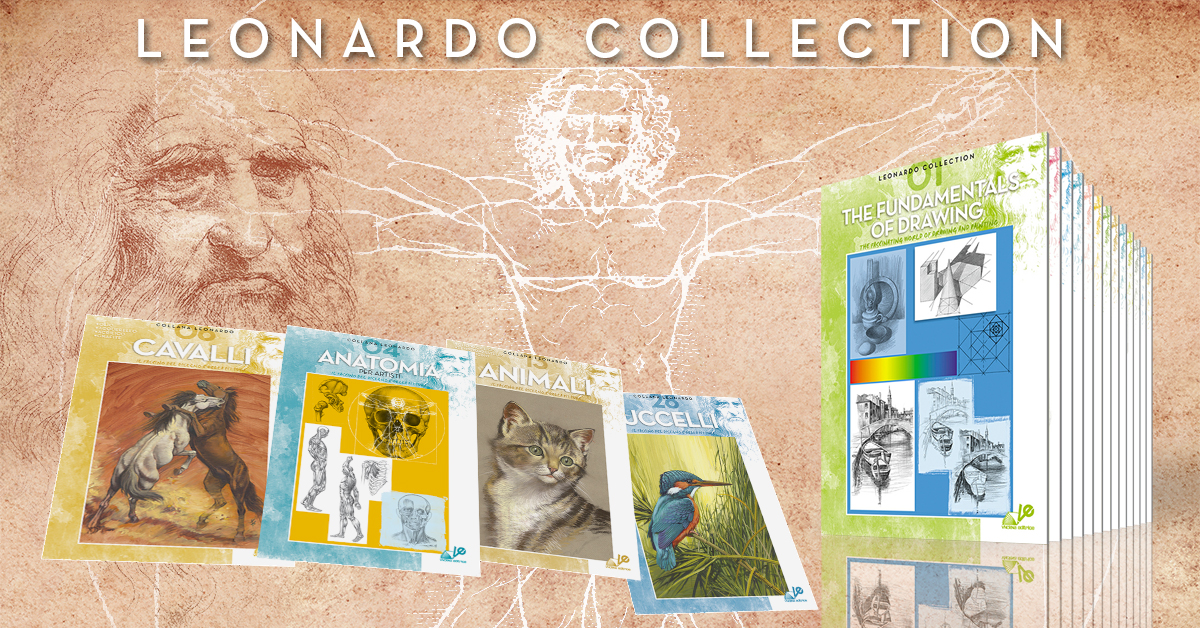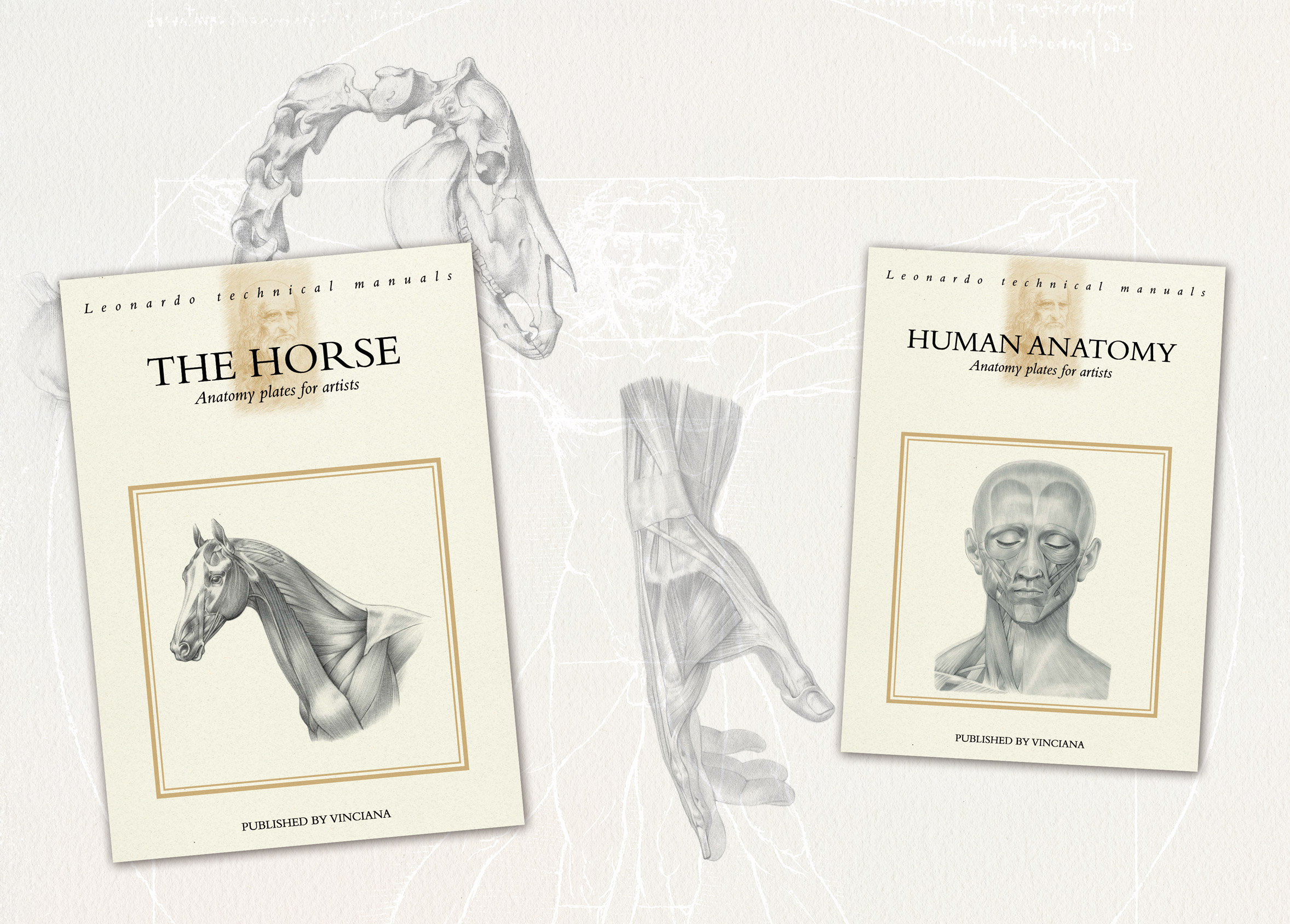- About us
- Company details
The Vinciana Editrice publishing company was first set up in 1976 by Floriano Bozzi, and ever since it has remained very much a family-run concern. Floriano Bozzi was spurred on by his innate curiosity for all kinds of painting techniques as well as by his wide-ranging experience in the field of drawings and illustrations. With the help of friends and colleagues, he created the Leonardo Series of art books, aimed at anyone who, whether for interest or professional reasons, wanted to develop their knowledge of the more traditional painting and drawing skills. Very much aware of the budding artist’s initial difficulties, and recalling the weaknesses of the first drawing and illustration manuals he himself had followed, Floriano Bozzi based the Leonardo Series on the humble principle of practicality, the aim being simply to help the learner. Three volumes on the basics of drawing, together with those dealing with anatomy and perspective, were the foundations on which the Series has grown.
The first volumes were published in Italian, later to be followed by French versions, and German ones. Over the years, the Leonardo Series has been translated into a variety of other languages (Spanish and English), including Arabic, Hungarian, Indonesian, Polish and Romanian.
After the loss of Floriano Bozzi in 1995, his son Riccardo has continued and developed the Series in full respect of the initial intent. Vinciana Editrice publications are now marketed in several Countries throughout the world, and some volumes have even been adopted as textbooks in schools and academies for the training of artists.
The entire Leonardo collection is composed by 48 titles, they measure 244 mm x 344 mm (9,6 inches x 13,54 inches), the weight is approx. 0,2 kg.
All the titles have 36 pages (cover included) except the first title which has 40 pages (cover included) and the book n.48 which is composed by 64 pages.
The cover is printed on plasticized semi glossy coated paper 200 gr/m2 and the inside is printed on matted coated paper 130 gr/m2.
6 titles are printed mono-color front + mono-color back
6 titles are bi-color front + bi-color back
21 titles are 4-color front + mono-color back
6 titles are 4-color front + bi-color back
9 titles are 4-color front + 4-color back
Over the years, Vinciana Editrice publications have been renewed and improved as far as graphics and production quality are concerned.
The Leonardo Series has been joined by the “Leonardo Technical Manuals”, a series that delves deeper into aspects relating to anatomy. Two volumes have been published, dealing with the study of human anatomy and horse anatomy for art students.
The publishing activities of Vinciana Editrice clearly do not reflect the rhythms of large-scale publishers. But the advantages of a family-run business are to be appreciated in the thorough, carefully-produced, reasonably-priced volumes and opportunity to create customized editions. The edition developed for the Polish market was re-paginate and published in A4 size following the customer’s request.
On various occasions, Vinciana Editrice has been invited to flood the market with new publications lacking in the serious, professional approach that has always been associated with the company. But the decision has always been to keep to a limited output, aimed at an appreciative public who value care and attention.
Year of establishment:
1995
Number of employees:
0
Annual turnover:
Under 250.000 Euro
Reference year of turnover:
2020
Export turnover:
From 75.000 to 250.000 Euro
Activities:
EDITORIAL ACTIVITIES
EDITING OF BOOKS, PERIODICALS AND OTHER EDITORIAL ACTIVITIES
Printing of books
Other artistic and literary creations
- Videos
- Catalogue
In questo video ci proponiamo di mostrarvi come ottenere superfici sfumate con differenti strumenti. Spesso i disegnatori ricorrono al dito per sfumare dettagli del proprio bozzetto ma, nel caso di superfici ampie, è comodo ricorrere ad altri metodi. Nel video abbiamo comparato tre semplici sistemi: lo sfumino di cartone, il panno carta e lo straccio di cotone. Il risultato è leggermente differente per ciascuno dei metodi. Da oltre 40 anni la nostra casa editrice si dedica alla pubblicazione di libri per l'apprendimento del disegno e della pittura.
La gomma è uno strumento potente, oltre a consentirci di rimediare agli errori ci fornisce l’opportunità di lumeggiare: in sostanza schiarire/alleggerire determinati toni di grigio per ottenere zone di luce nel nostro bozzetto. La gomma pane è perfetta per asportare grafite e/o carboncino in maniera graduale; ci permette, tamponando sulla carta, di dosare correttamente i toni chiari del nostro disegno. La gomma di plastica, molto più “invasiva”, ci consente di cancellare e riportare la carta quasi al bianco originale (dipende dalla densità della campitura e dal mezzo utilizzato); in questo modo si possono esaltare i punti di massima luce.
Un time lapse con le fasi di lavoro di una natura morta dipinta con colori a olio su tela formato cm 70x50. Il soggetto è tratto da una foto di una serie di bottiglioni esposti in una bancarella di un mercato florovivaistico. I colori, il gioco di trasparenze e riflessi sono gli elementi caratterizzanti del dipinto. Come già osservato in altri video, il lavoro è cominciato con un abbozzo piuttosto dettagliato al quale è seguito una costruzione del dipinto progressiva. La visone di assieme è importante: il dipinto ha le sue fondamenta, come una casa, sulle quali si edifica e sviluppa l’intera costruzione; partire dal tetto o dagli infissi senza avere uno sviluppo armonico complicherebbe o addirittura vanificherebbe il lavoro. Il nostro intento è di stimolare lo spirito creativo e la voglia di esprimersi graficamente che è dentro ciascuno di noi. Speriamo che questo piccolo contributo vi sia di incentivo a impugnare matita e pennelli.
Da oltre 40 anni la nostra casa editrice si dedica alla pubblicazione di libri per l'apprendimento del disegno e della pittura. Nella Collana Leonardo proponiamo numerosi esempi di soggetti classici quali: fiori, nudi, animali, nature morte, paesaggi, realizzati nelle più disparate tecniche di disegno e pittura. In questo video potrete sfogliare con noi le pagine del n.06 dedicato ai Cavalli, alcune pagine sono dedicate all'anatomia dei nobili animali.
- Contact Information
- Business Proposals
Company:
VINCIANA EDITRICE S.A.S.
Web site:
Address:
VIA VINCENZO FOPPA 14
City:
MILANO (MI)
Zip Code:
20144
E-commerce:
Social media:
Tag:
No business proposals uploaded
- Map
LEONARDO COLLECTION

Designed and created as both a valuable tool for beginners and a strong support for professional artists, the Leonardo Collection stands out for its clear explanations, plain language, and especially for its intelligent, well-directed choice of illustrations.
The Collection offers exhaustive information on methods and strategies in both drawing and painting, starting from the basics of drawing and gradually presenting various media and techniques in a vast range of subjects. The first five titles of the series have been adopted by many art schools throughout the world because of the informative and easy to follow step-by-step practice and demonstration approach.
Each manual in the Leonardo Collection explores a single subject matter, but taken together they create a comprehensive survey of drawing and painting useful for artists of all levels and abilities who want to expand their knowledge and skills.
LEONARDO TECHNICAL MANUALS - Anatomy plates for artists

After more than 40 years in the field of drawing and painting through publication of the Leonardo Collection, Vinciana Publishing has decided to utilise its vast experience by issuing these two volumes devoted to the anatomy of the horse and the human body. These volumes have a unique special appearance, inspired by anatomy texts from the late nineteenth century. Each volume consists of 48 loose plates plus an instructional text. The structure of the volume permits readers to use the individual plates without the restrictions imposed by bindings; for example, one can put two plates side by side - whether these illustrate the head, the thorax, or another part - and compare bone structure to muscle structure. Each plate is numbered and indicates both the part illustrated and its scientific nomenclature. Consequently the use of the plates is independent from the text, and reading is a choice left to those who would like to improve their knowledge of anatomy.


